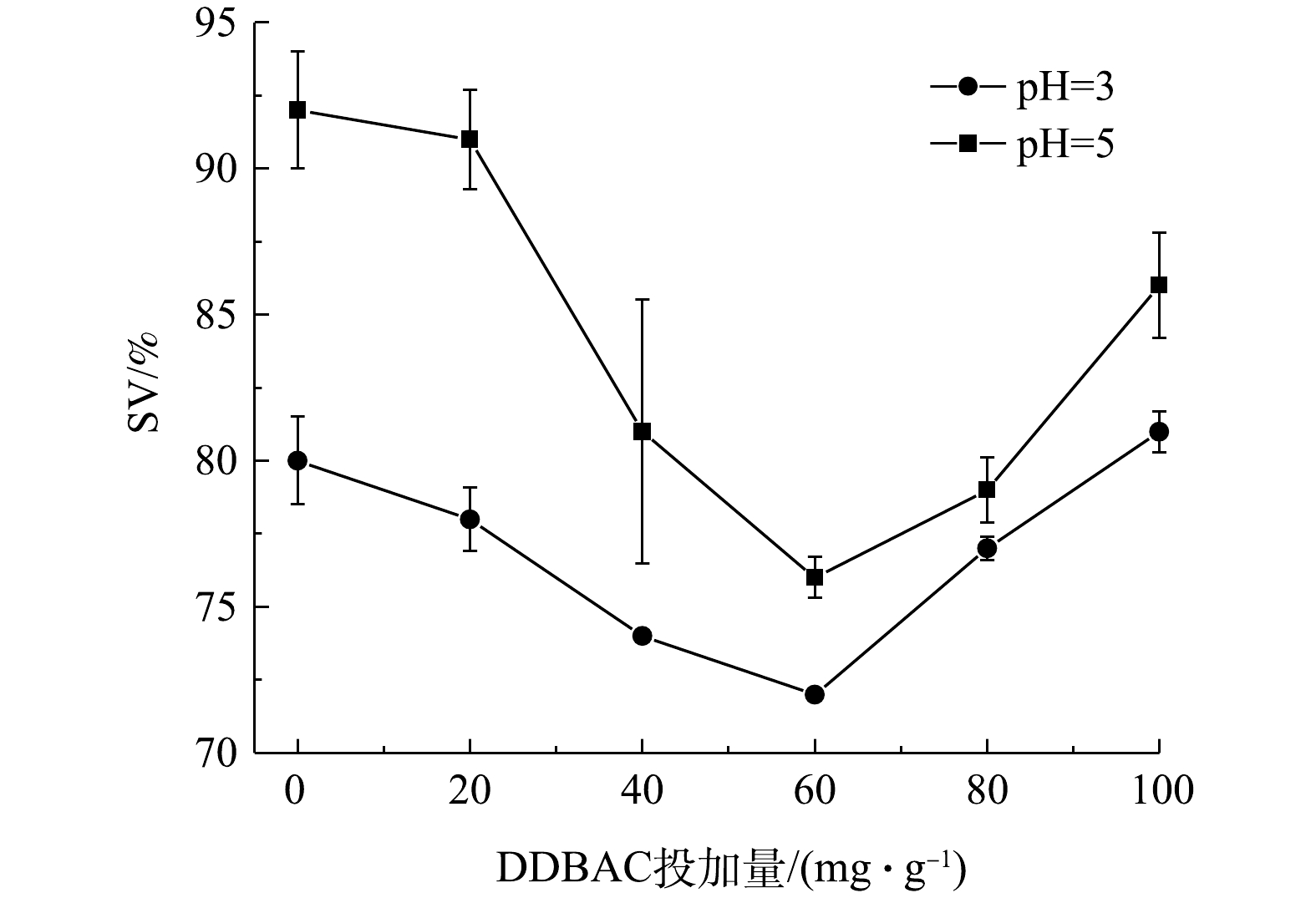全文HTML
--> --> --> 市政污水处理厂产生的剩余污泥因其胶体结构与高亲水性质而导致其部分水难以脱除[1-2]。剩余污泥经浓缩或机械脱水后,含水率一般仍在80%以上。高含水率造成了污泥体积庞大、运输成本高、占用处理场地大以及处理处置困难等问题[3]。因此,如何经济有效地降低污泥的含水率成为了污泥处理的关键问题之一。一些研究者发现,污泥表面的胞外聚合物(EPS)是造成污泥脱水困难的重要因素之一[4-6]。剩余污泥有机物组成中50%~60%是EPS,而EPS中的70%~80%是蛋白质(PN)与多糖(PS)等大分子有机物[7]。在不同污泥中,EPS的组成亦不同[8]。PN与PS通过氢键等作用力将部分水锁定在污泥表面形成水膜,致使这部分水无法通过常规的机械方法被脱除。因此,有研究者将芬顿高级氧化的方法引入到污泥的脱水处理中,依靠其产生的羟基自由基破坏污泥表面的EPS结构,从而达到提高污泥的脱水性能的目的[4, 9]。但是,苛刻的反应条件限制了常规芬顿方法的应用。芬顿处理使用的H2O2存在较高的运输、保存费用,故有报道[10-12]用氧化能力稍差的过硫酸盐高级氧化法代替传统的芬顿氧化法。虽然效果不如传统的芬顿方法,但过硫酸盐的经济性更优,使其成为了研究的热点。也有研究者[3, 13]通过加快Fe3+向Fe2+的转化速率而改用Fe3O4或Fe0的类芬顿方法;通过加快自由基的生成速率从而达到提高污泥脱水性能的目的。传统经芬顿方法处理后的污泥粒径小,易堵塞过滤通道,不利于脱水[1]。为了优化污泥脱水效果,通过表面活性剂的强絮凝作用[14-16]或在体系中引入CaO等具有刚性晶格结构[17-19]的骨架成为新的研究热点。
阳离子表面活性剂因其能同时促进污泥表面EPS的溶出与转化[20]受到了研究者的青睐。十二烷基二甲基苄基氯化铵(DDBAC)作为一种工业上经常使用的阳离子表面活性剂,已被证实单独作用于污泥时有较强的絮凝作用[21]。但是,昂贵的价格和较大的投加量限制了对他的推广和应用。CaO作为骨架结构作用于污泥时效果显著,但其存在投加量过高(100~200 mg·g?1)的问题。经CaO处理后的污泥体系碱性过强[22],且处理污泥易板结,有机物含量低,进而影响污泥的最终处置。
为了减少CaO的用量,同时提高污泥的再絮凝能力,保证处理后体系的pH接近中性。本研究将CaO与DDBAC联用于最适条件下芬顿调理后的污泥,并分析污泥脱水过程中EPS的转化规律;通过在pH为5的弱酸性条件下重复上述实验,以期通过两者的协同作用来达到共同提高污泥脱水效果的目的;同时避免体系投入过多的酸调节pH,为后续芬顿方法在弱酸条件下的应用提供参考。
1.1. 供试原料及设备
污泥取自成都市某污水处理厂二沉池。该污水处理厂采用的是改良A2/O工艺,处理规模为1.5×104 m3·d?1,污水来源于服务区范围内的生活污水。由于原始污泥含水率过高,取回的污泥静沉24 h后,弃去上层清液再用于实验。样品分2批次采集,每批样品的实验在72 h内完成。污泥的基本特性见表1。浓硫酸(H2SO4)、七水合硫酸亚铁(FeSO4·7H2O)、质量分数30%过氧化氢(H2O2)、氧化钙(CaO)、十二烷基二甲基苄基氯化铵(DDBAC)均为分析纯。
六连异步电动搅拌器(JJ-4B型,常州市国旺仪器制造有限公司);数显酸度计(PHS-25型,杭州雷磁分析仪器厂);电热恒温鼓风干燥箱(DHG-9030A,上海一恒科学仪器有限公司);台式低速离心机(TD-420型,四川蜀科仪器有限公司);紫外可见分光光度计(UV-4802H型,上海尤尼柯仪器有限公司)。
1.2. 实验方法
芬顿反应对pH有严格的要求,忽略目标物时最佳pH为3.0左右[23];提高体系pH,当pH超过5时,H2O2分解速率加快[24],且有更多水合氧化铁与氢氧化铁生成,影响Fe2+的利用。因此,本实验在pH为3和5的条件下进行实验。前期预实验得到最优的Fe2+和H2O2用量分别为30、60 mg·g?1(DS);由于处理后的酸性环境不利于DDBAC充分发挥作用[21],故在本实验中CaO在pH为3和5条件下的用量分别为60、40 mg·g?1(DS),此时反应后体系的pH在7.0左右。量取待试样品污泥600 mL置于1 000 mL烧杯中;加入硫酸,调节污泥pH至3或5;加入FeSO4·7H2O,300 r·min?1搅拌5 min后,再加入30%H2O2,180 r·min?1搅拌30 min;后加入CaO,180 r·min?1搅拌5 min;最后加入DDBAC于180 r·min?1下搅拌30 min。
1.3. 分析方法
滤饼含水率的测定采用重量法;CST测定采用毛细吸水时间测定仪。TTF检测。取调理后的污泥200 mL,倒入装有定量滤纸的布氏漏斗中(直径150 mm),在真空压力为0.04 MPa的负压条件下进行抽滤脱水,记录抽滤瓶内量筒收集滤液达到100 mL时所花的时间,即为TTF[25]。
用改进热提取方法[26]提取各层EPS;将上述提取出来的EPS立即使用注射器过0.45 μm孔径的滤膜并保存,各层EPS中的多聚糖采用蒽酮-硫酸比色法测定,以葡萄糖作为标准样[27];蛋白质采用考马斯亮蓝染色法测定,以牛血清蛋白作为标准样[28]。
SV测定。取100 mL调理后的污泥于100 mL的量筒中,记录30 min后污泥于清液的分离界面高度v,污泥沉降比计算方法如式(1)所示。
2.1. DDBAC投加量对污泥脱水性能的影响
图1为DDBAC投加量对不同pH条件下污泥脱水效果的影响。当污泥在pH为3的芬顿氧化钙体系下时,泥饼的含水率随DDBAC投加呈现出先降低后增加的趋势。投加DDBAC前,泥饼的含水率为72.55%;当DDBAC投加量达到60 mg·g?1(DS)时,含水率降低至最低的68.57%。污泥在pH为5的芬顿氧化钙体系下,DDBAC投加量对污泥脱水效果的影响同pH为3时一致。由此可以发现,在芬顿与氧化钙联合调理后,DDBAC投加量在60 mg·g?1(DS)时,污泥的脱水效果是最好的,其投加量与HONG等[20]的DDBAC最优结论相近。经芬顿处理后,污泥颗粒粒径会显著变小,小粒径颗粒在抽滤脱水时容易堵塞过滤通道,从而造成污泥脱水率较低的现象[29]。CaO的添加不仅调节了pH,促进氢氧化铁絮体的形成,同时也会生成硫酸钙等具有刚性晶格结构的物质[19];同时,通过氢氧化铁的网捕卷积作用在污泥中重新絮凝形成具有较强抗压能力的絮体结构,造成芬顿氧化钙体系处理后的污泥具有较好的脱水效果。在本研究中,后加入的阳离子表面活性剂DDBAC,因电性中和作用,进一步促进了污泥的絮凝,使污泥絮体的粒径增大。因此,出现泥饼含水率随着DDBAC的投加量增加而降低的趋势,但当DDBAC过量时,污泥的电性升高,污泥难以继续絮凝沉降。值得一提的是,在pH为5的弱芬顿条件下,该体系仍有较好的脱水效果,相较于DDBAC的单独调理最佳用量[21],该联合体系也达到了减少DDBAC用量的目的。
2.2. DDBAC投加量对污泥沉降性能的影响
DDBAC投加量对不同pH条件下污泥沉降性能的影响如图2所示。在pH为3和5的条件下,污泥的沉降性能随DDBAC的投加量增加,均呈现出先降后增的趋势,在DDBAC投加量为60 mg·g?1(DS)时达到最低的72%和76%,相较于未投加DDBAC时,这一阶段的提升率分别为8.51%和19.15%。这是由于,DDBAC作为一种阳离子表面活性剂,当其溶于污泥的时候,其极性基团电离带正电,而污泥带负电。随着电中和作用的发生,污泥体系电势进一步趋于0,污泥更易于发生絮凝沉淀[30]。因此,一开始污泥的SV随着DDBAC投加量的增加而降低。当DDBAC投加过量时,原本趋于0的电势开始升高,污泥又变得稳定而难以絮凝沉淀,因此SV开始升高。另一方面,由于表面活性剂的增溶作用,其极性基团可与EPS中蛋白质与多糖结合,形成复合物,降低液固界面的张力,从而增加这些难溶物的溶解度[31],导致污泥表面结合水的脱除,进而提高了污泥的沉降性能。在低pH条件下虽然污泥沉降性能较好,但在高pH条件下,DDBAC对体系沉降性能的影响更明显。2.3. DDBAC投加量对污泥CST与TTF的影响
DDBAC投加量对pH为3条件下污泥CST与TTF的影响如图3(a)所示。CST与TTF的变化呈现出一样的趋势,随着DDBAC投加量的增加,CST与TTF呈现出先降低后升高的趋势。在DDBAC投加量为60 mg·g?1(DS)时达到最低,分别为24 s和44 s,相较于未投加DDBAC时的降低率分别达到22.58%和31.25%。在pH为5条件下,污泥调理后的CST与TTF变化如图3(b)所示,其变化趋势同pH为3时,在DDBAC投加量为60 mg·g?1(DS)时达到最低,此时相较于未投加DDBAC时的降低率分别为29.17%和36.84%。这是因为,在低pH条件下,芬顿反应生成的羟基自由基破坏了污泥表面EPS的稳定结构[3],污泥表面水膜中的结合水得以释放。结合氧化钙的骨架作用,保证了过滤时孔隙的畅通。因此,TTF与CST降低明显。但氧化钙的投加量有限,随着DDBAC的加入,其电性中和作用促使污泥再絮凝,粒径进一步增大。而且由于DDBAC的增溶作用,促使部分难溶于水的有机物溶解进入液相,结合水得以释放,导致CST与TTF继续降低。但当DDBAC投加量继续增加时,污泥体系电势升高,絮体趋于稳定,相较于最优条件时絮体粒径减小,脱水能力下降。另外,可能是污泥细胞发生了裂解,胞内大分子有机物大量释放,从而对脱水造成了负面影响[29]。不难发现,在弱芬顿条件下,联合体系的处理效率低于在pH为3的条件下的最优效果,但远高于芬顿氧化钙体系的效果;而且,DDBAC在弱芬顿条件下的效果更显著。这为芬顿体系在弱酸条件下的利用提供了参考。2.4. DDBAC投加量对污泥各层EPS含量的影响
DDBAC投加量对pH为3条件下污泥各层EPS中PN和PS的影响如图4(a)、图4(b)所示。原泥中PN、PS的含量超过80%存在于紧密结合型胞外聚合物(T-EPS)中,这与WANG等[32]的结论相近。经芬顿氧化钙体系处理后的污泥,EPS中PN与PS有由内层向外层溶出的趋势。芬顿氧化过程产生的羟基自由基破坏了污泥表面的EPS结构,使得原本难溶的松散结合型胞外聚合物(L-EPS)和T-EPS向可溶性溶解型胞外聚合物(S-EPS)转化,这一过程促进了PN与PS等大分子有机物的水解过程,并使附着在其表面的水进一步溶出。随着DDBAC投加量的增加,污泥EPS中PN与PS的总量呈现出先降低后增长的趋势,在投加量为60 mg·g?1 (DS)时达到最低,分别为109和47 mg·L?1;相较于未投加DDBAC时,降低率达到48.10%、32.86%。S-EPS与T-EPS中PN和PS含量呈现出同总量一致的变化趋势。而L-EPS中PN和PS的含量变化并无规律可循。因芬顿的前处理,原本紧密的EPS结构变得松散,DDBAC投加量在60 mg·g?1(DS)以前,T-EPS中PN与PS含量进一步降低,DDBAC的增溶能力,促进了难溶EPS的进一步转化。但此时,S-EPS中PN与PS含量并没有增加而是减少了,这与HONG等[20]和HONG等[33]的结论相近。这是因为,在芬顿处理后,难溶性有机物发生部分水解,在DDBAC增溶过程中,同时又促进了大分子有机物的水解转化,此时水解效果强于增溶效果,其结果就是S-EPS中PN、PS含量降低。当DDBAC投加量达到100 mg·g?1(DS)时,各层EPS中PN、PS含量激增。这可能是因为,芬顿处理后污泥中仅剩部分难溶性EPS,在DDBAC进一步处理后,EPS含量降低,过多的DDBAC其表面疏水烷基附着在污泥细胞表面,抑制了营养摄入,致使污泥破解[34]。此时,细胞内PN、PS的流出,其表面的极性基团又开始吸附液相中的自由水,造成污泥的脱水能力下降。这也解释了在2.3节,当DDBAC投加量超过60 mg·g?1(DS)时,CST与TTF激增的原因。值得一提的是,DDBAC对污泥中PN的增溶效果明显强于对PS的效果。这可能是因为,PN由多种氨基酸构成,依靠肽键连接的单链结构,易于遭受自由基等的攻击裂解,而PS是由多个单糖以糖苷多个位点连接而形成的复杂的长链网状结构,能大大减少水分子在其结构内的移动,因此,表面活性剂对其作用较难进行[35-36]。DDBAC投加量对pH为5条件下污泥各层EPS中PN与PS的影响如图4(c)、4(d)所示。经过芬顿氧化钙体系处理后,EPS中PN和PS的总量下降趋势,与pH为3时的趋势一致,L-EPS中PN、PS的含量变化并无规律可循。不同的是,S-EPS中PN与PS的含量略有升高。随着DDBAC的投加量增加,EPS总量与T-EPS中PN、PS含量变化一致,呈现出先降低后增长的趋势,在投加量为60 mg·g?1(DS)时达到最低。不同的是,S-EPS中PN、PS含量则呈现出一直增长的趋势。这是因为,在pH为5的弱芬顿条件下产生的羟基自由基数量有限,只能将污泥中的部分EPS氧化。随着DDBAC投加量增加,更多的T-EPS向S-EPS和L-EPS转化。虽然EPS总量的慢速降低证实了水解过程仍在继续,但S-EPS中PN与PS的含量增长则证明了此时的增溶效果更强。因此,T-EPS更能较S-EPS作为表征污泥脱水效果的参考依据。而以上结果也证实了芬顿氧化钙的前处理对DDBAC深化污泥脱水有较好的作用。
2)在pH为5的弱芬顿条件下,DDBAC对污泥体系SV、CST和TTF的降低率更高。其原因是,芬顿过程产生的羟基自由破坏了污泥表面EPS的稳定性,使部分难溶性EPS得到初步水解,此时,DDBAC增溶效果更显著;而在pH为3时,芬顿过程已将体系大部分难降解有机物水解,此时DDBAC的增溶效果不明显。
3)芬顿CaO体系联合DDBAC可以在降低CaO的用量的同时,提高污泥的脱水能力,相较于DDBAC的单独处理,该体系也可以有效降低DDBAC的用量。
4)在芬顿CaO前处理条件下,在一定范围内,EPS总量随DDBAC投加量增加而降低;而且在污泥各EPS层中,T-EPS相较于S-EPS和L-EPS,与污泥脱水性能有更强的联系。
参考文献


 下载:
下载: 


 点击查看大图
点击查看大图